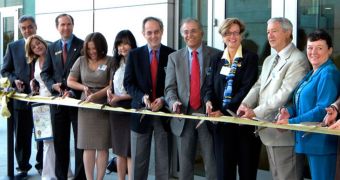In the presence of lawmakers and local dignitaries, officials at the NASA Jet Propulsion Laboratory (JPL), at the California Institute of Technology, in Pasadena, cut the ribbon on a new, environmentally friendly Flight Projects Center building at the lab today. The new structure is the American space agency's greenest to date, and it will become a home to most of the JPL projects that are still in their design and development phases, a JPL press release announces.
“It seems fitting that the new building, where teams will plan future space missions that use new technologies, also has the latest 'green' technologies to help JPL do its part to improve our environment here on Earth,” JPL Director Charles Elachi said. He is one of the officials who helped with the ribbon-cutting ceremony. Other attendants included US Rep. David Drier; Laura Olhasso, the mayor of La Canada-Flintridge, as well as staff representing US Rep. Adam Schiff, and the Caltech President, Jean-Lou Chameau.
Another advantage that the new Center will have is the fact that it will allow for scientists and engineers to collaborate more closely together, despite their nationalities and backgrounds. In this sense, the new building will increase scientific cooperation and improve the overall quality of the projects that come out of the JPL. When the building was analyzed in terms of energy efficiency, it was viewed under the terms of the Leadership in Energy and Environmental Design rating system. It received the “LEED Gold Certification” for its design.
Among the numerous new features that the Center has, scientists mention the living roof that helps maintain inside temperatures, the directed outdoor lighting, for reduced light pollution at night, the smart heating and cooling systems, the reduced faucet flows, and the surfaces covered with a special paint that has low amounts of toxic fumes in it. About 75 percent of the debris that was obtained building the structure was redirected to a landfill, and then to a recycling center. The wood in the building was bought from the Forest Stewardship Council, which promotes sustainable forest exploitation.

 14 DAY TRIAL //
14 DAY TRIAL //